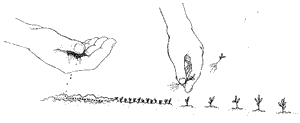Marigolds are called half-hardy, because they can stand some chill in the fall. They are eventually killed whenever freezing temperatures arrive in the area. Marigolds like full sun but they can tolerate up to 20% shade if the light is still bright for the rest of the day. Hot, sunny, southern exposures promote the heaviest bloom. Marigolds will give more and better bloom in poor soil than in rich. They do not do well in clay. Because they are not thrilled to be transplanted, if possible do it when seedlings are small and have only 6 leaves or so.
Growing From Seed Indoors
Marigolds are easy to grow from seed, either indoors under lights or outdoors in the garden. Sprinkle seeds over a shallow box or peat cups filled with damp soilless potting mix and cover with a 1/4 inch layer of the medium. At about 60 degrees, seeds will germinate in 3 or 4 days. Keep sprouts moist and transplant them singly into growing containers or directly to outdoor garden beds after 10 days. For details about starting seeds indoors and out, see Starting Plants From Seed and check out Seed Starting Equipment and Supplies in Yardener’s Tool Shed.
Growing From Seed Outdoors
Sow seeds directly into the garden bed after all danger of spring frost is past. Prepare the planting area by clearing away any stones and debris. Dig down into the soil about 8 or 10 inches with a trowel or shovel and turn it over to loosen and aerate it. If the soil is thin mix in some organic matter such as peat moss, compost or chopped leaves to improve its drainage and ability to hold moisture. Break up any large soil clumps, then smooth and level the area. Sprinkle seeds on the soil as recommended on the seed packet label and cover with a thin layer of soil. Keep soil moist.
 |
Planting Seedlings
Plant seedlings purchased at the garden center or nursery, or those you've started indoors, as soon as danger of frost is past and the soil is warm. French, signet and triploid marigolds can be planted through midsummer, but American marigolds should be planted in spring because they are slower to mature. Choose young plants that are bushy and in bud, but not in bloom. Plant on an overcast day, or later in a sunny day so that the seedlings are shielded from hot sun while they get established. Keep their soil moist.
Prepare the planting area by clearing away any stones and debris. Dig down into the soil about 8 or 10 inches with a trowel or shovel and turn it over to loosen and aerate it. If the soil is thin mix in some organic matter such as peat moss, compost or chopped leaves to improve its drainage and ability to hold moisture. Break up any large soil clumps, then smooth and level the area. Dig holes about the size and depth of the seedling pots. Gently tip each seedling out of its pot and set it in a hole, taking care that it is at the same depth in the soil as it was in its pot. Fill each hole with plain soil, pressing it gently around the seedling to remove air pockets. Water well. Space smaller French and signet marigolds 8 to 10 inches apart, larger American and hybrids 10 to 18 inches apart.
Growing Marigolds In Containers
Marigolds make excellent plants for container growing either by themselves or in combination with other annuals or interesting foliage plants such as dusty miller, trailing vinca or ferns. They are suitable for planters sitting on the deck or patio or windowboxes. Be sure to fill containers with good quality soilless potting mix rather than garden soil. This mix is lighter, drains better, and is sterile so that plants avoid disease problems. Since it does not contain soil and its nutrients, mix in some slow-acting granular fertilizer when you plant or every few days add water them with a very dilute liquid general purpose fertilizer. Water regularly, as containers in the sun tend to dry out quickly.

